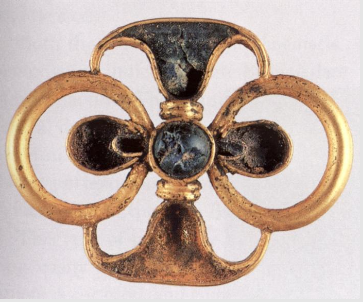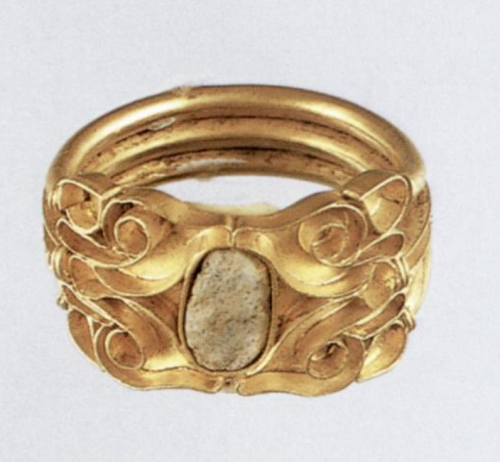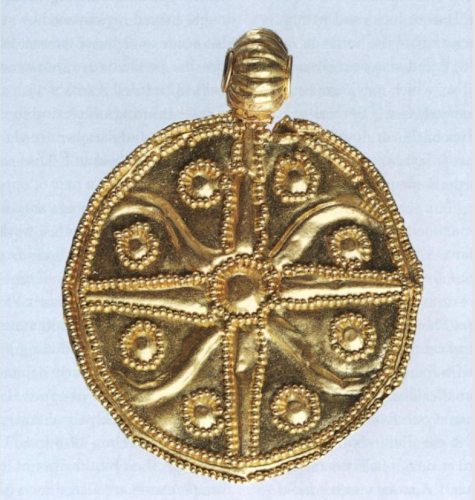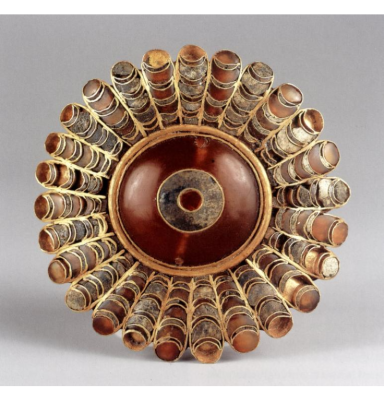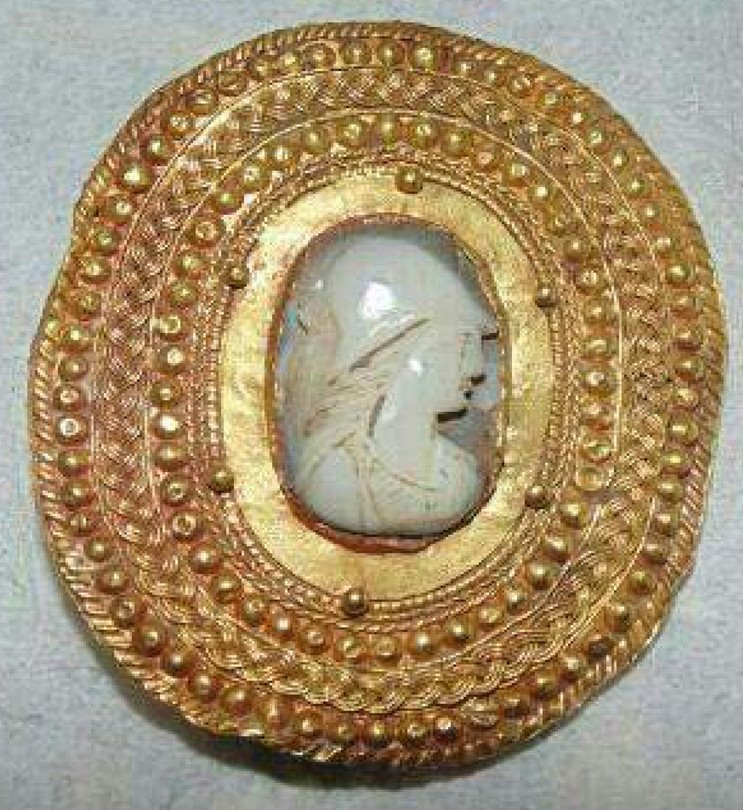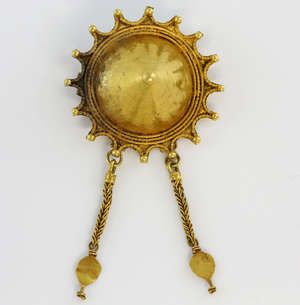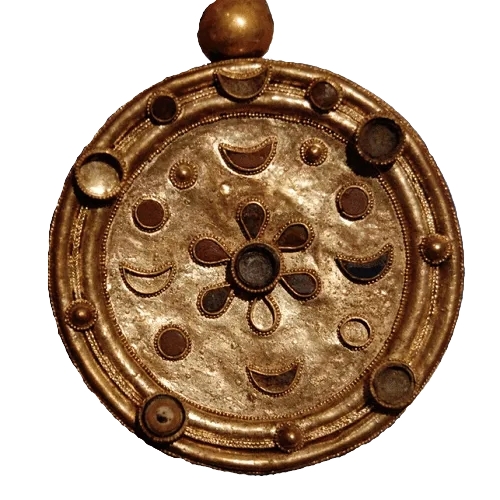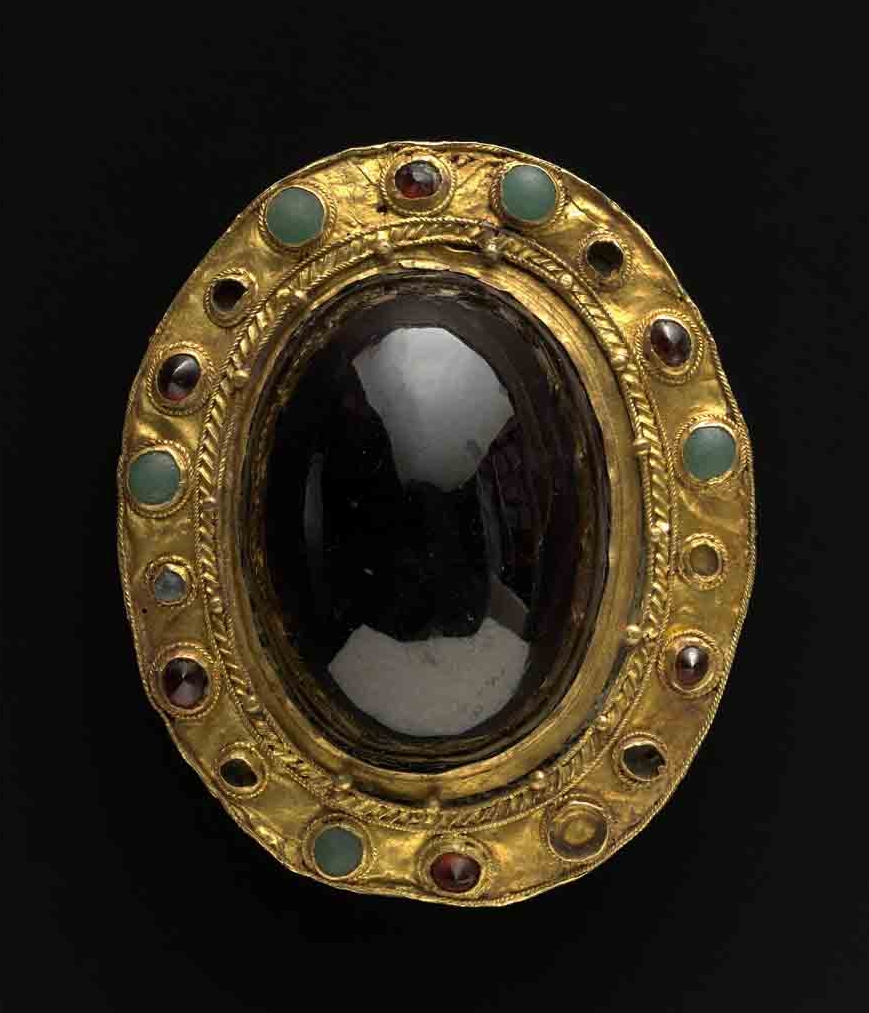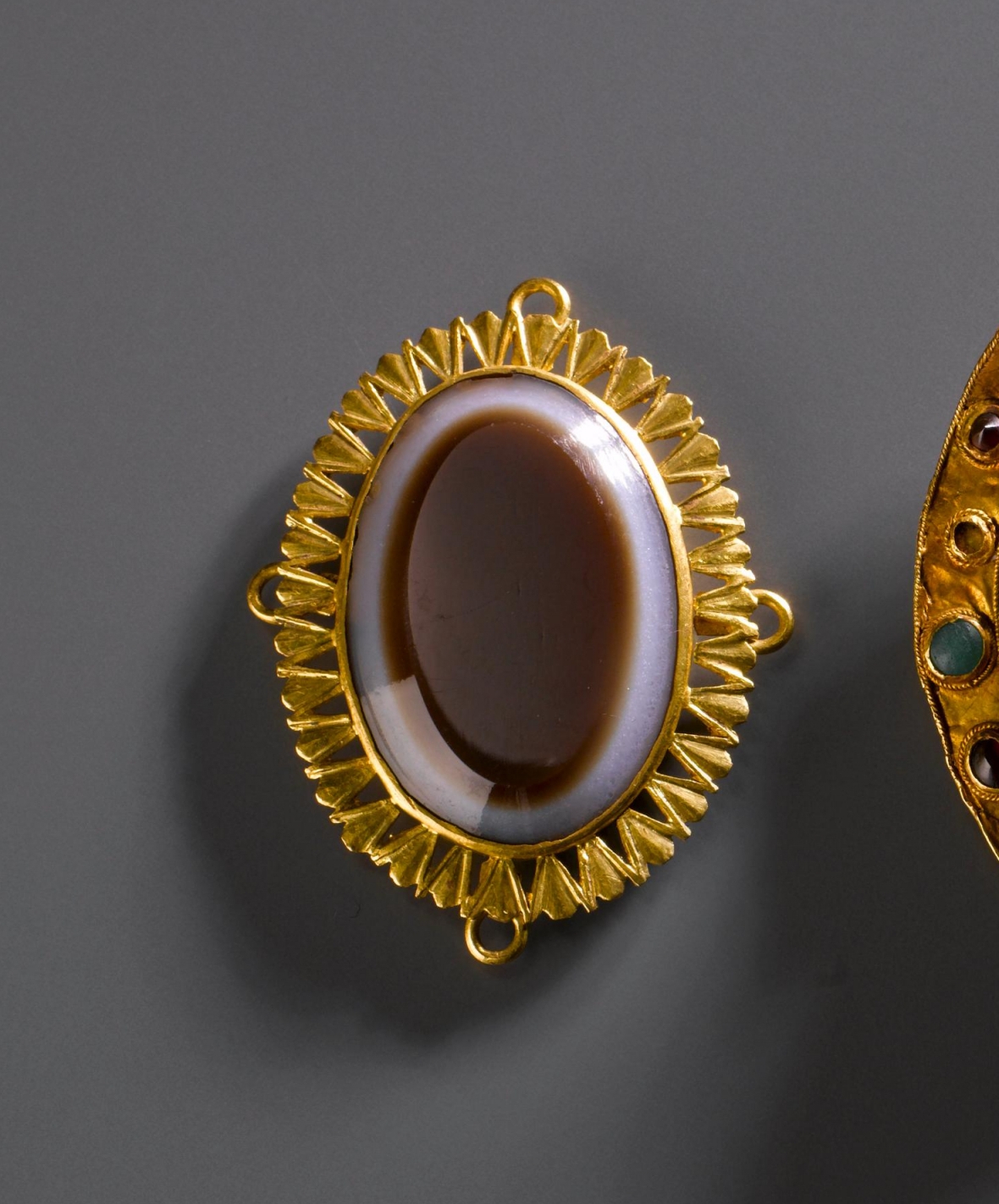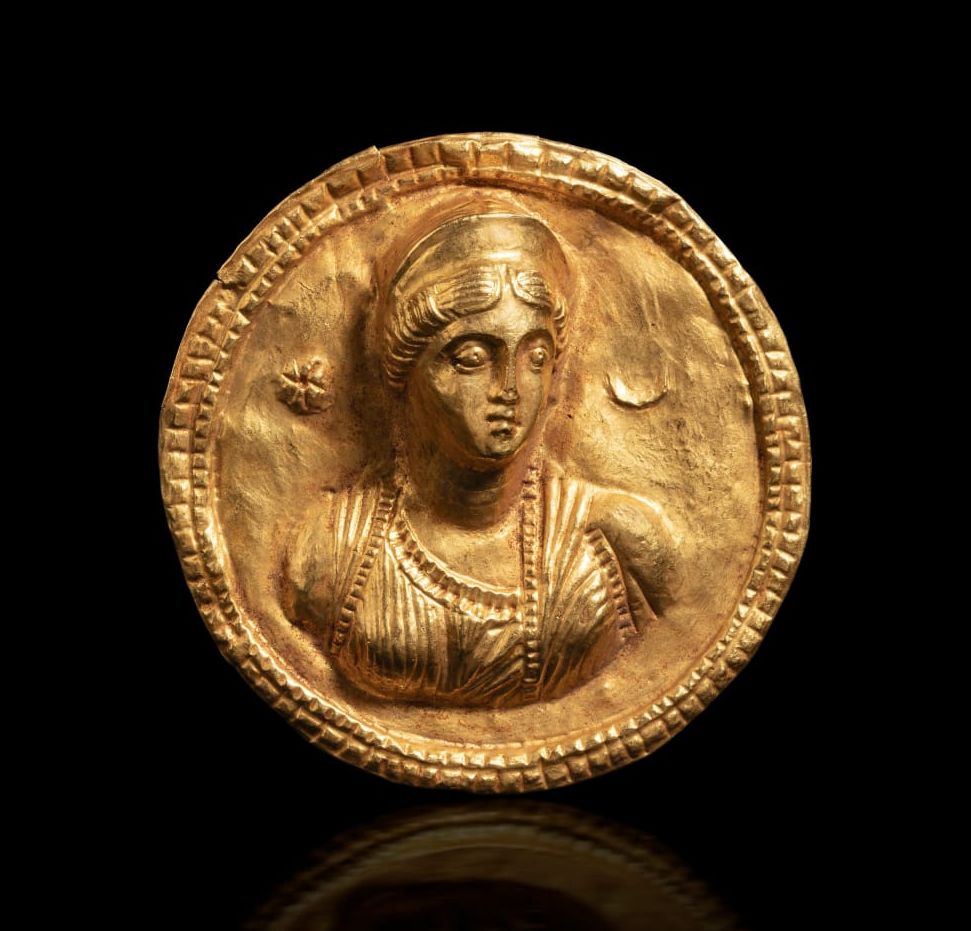page in progress
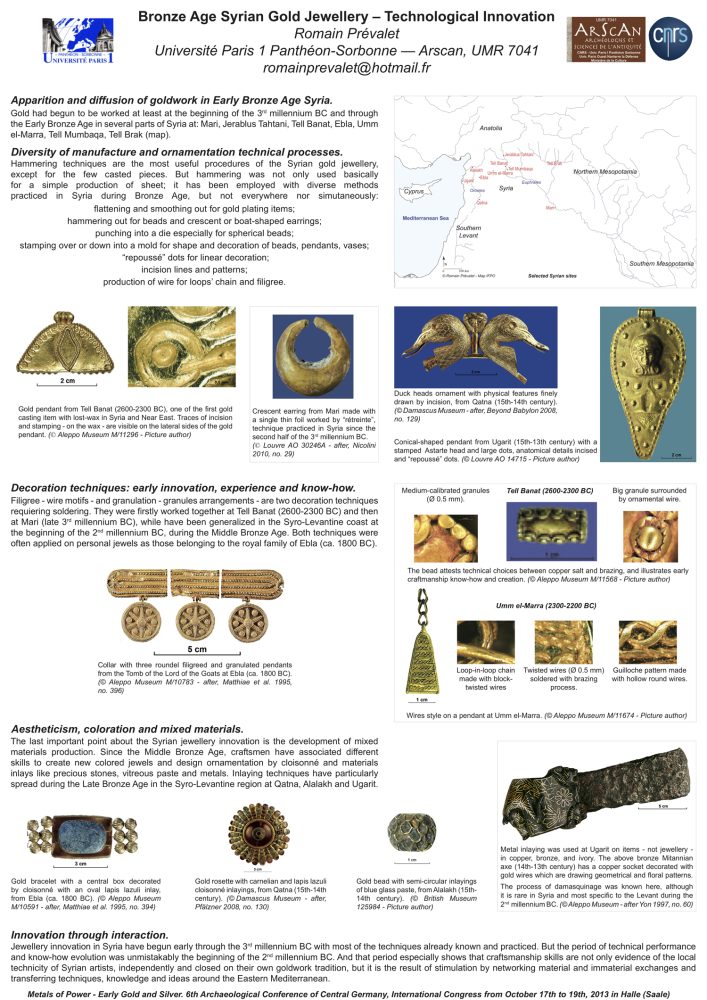
EBLA
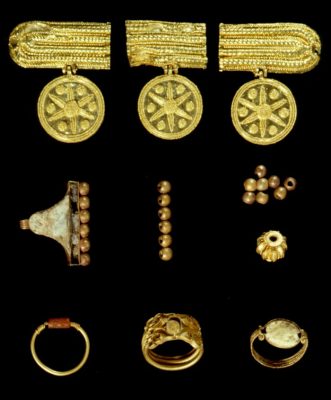
Photo source http://www.ebla.it/estoria_del_sito__storia_di_ebla.html
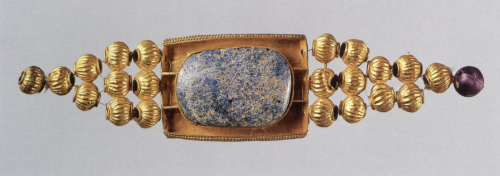
Bracelet, gold and lapis lazuli. Ebla, ca. 1800 BCE
Length: 10.2 cm, width: 2.5 cm.
“Gold bracelet from the Tomb of the Princess at Ebla, Middle Bronze Age I–II, c. 1800 BC. The piece is composed of a large central square-shaped setting inlaid with a lapis lazuli block attached to two bands of melon beads (modern reconstruction). The edge of the central block is surrounded by two twisted wire”
[Romain Prévalet, 2014]

Ebla
Necklace, gold
L. 10.4 cm, h. 4.4 cm, diam. discs 2.5 cm
Area Q. Royal Necropolis, Tomb of the Lord of the Goats, Hypogeum B
Middle Bronze II: ca 1750-1700 BC
Aleppo, National Museum, TM.79.Q.250a-c
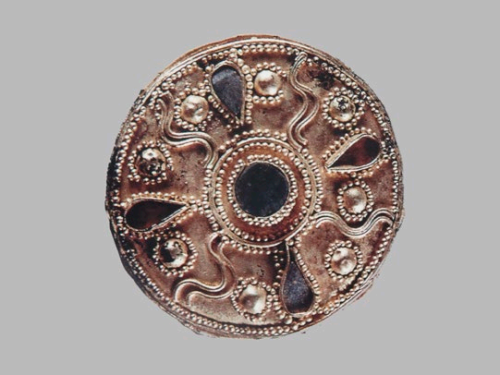
Decorative disc, a stud with granulated decoration. “For its shape, the stud was identified with the covering of the top end of a ceremonial stick” [Frances Pinnock]
Gold and lapis lazuli. Diam. 3 cm, th. 0.3 cm
Ebla; Area Q. Royal Necropolis, Tomb of the Lord of the Goats
ca 1750-1700 BCE
[read more]
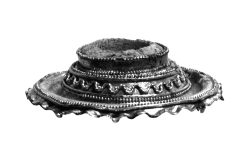
Gold stud TM.78.Q.408 with paste inlays from the Tomb of the Lord of the Goats at Ebla

Cylindrical gold handle cover from the Tomb of the Lord of the Goats at Ebla, Middle Bronze Age II, 1800–1700 BCE.
Length: 5 cm, diameter: 1.5 cm.
Aleppo (Syria), National Museum, Inv. No. M. 10587
“This object is wholly covered with a repeating motif of a filigree network surrounding granules within a framework of several consecutive round and twisted wires. It is likely that the numerous granules and wires were fixed with tiny joints on the surface by copper salt soldering.” [Romain Prévalet, 2014]
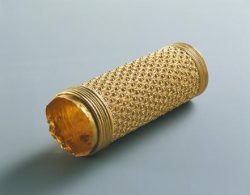
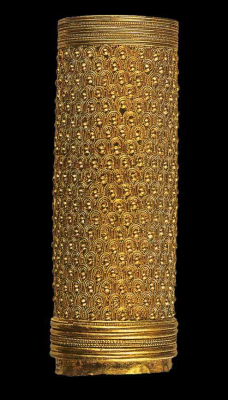
Ebla, Area Q. Royal Necropolis, Tomb of the Princess
Earring, Gold
Diam. 3.2 cm, th. 0.6 cm, w. 6.8 g
Middle Bronze I-II: ca 1825-1775 BC
Aleppo, National Museum
Ebla; Middle Bronze II: ca 1750-1700 BCE
Necklace with two pendants
Gold, rock crystal and greyish-green translucent stone
L. chain 22 cm, L. stones 2 cm, diam. 0.8 cm
Royal Necropolis, Tomb of the Lord of the Goats, Hypogeum C
Aleppo, National Museum.
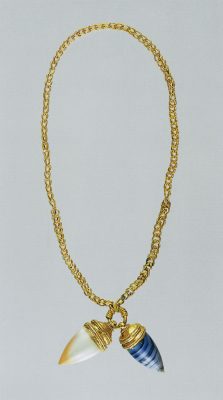

Ebla
Ring. Gold, pale blue vitreous paste
H. 2.2 cm, diam. 2.4 cm, l. 1.4 cm.
Area Q. Royal Necropolis, Tomb of the Lord of the Goats
Middle Bronze II: ca 1750-1700 BC
Aleppo, National Museum

MARI
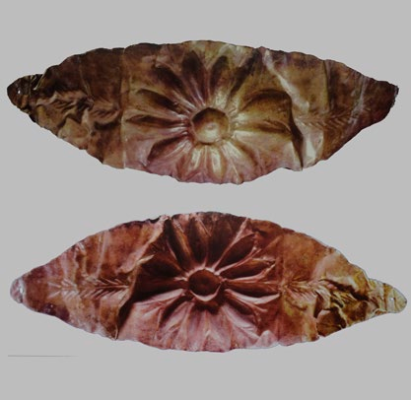
Gold sheet, L. 116 mm, w. 3.27 g
Deir ez-Zor, Archaeological Museum
Photo after Ibrahim Ahmad
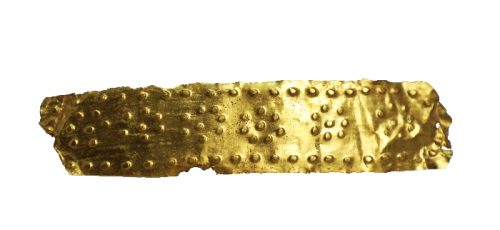
Syria, 1600-1200 BCE. Damascus Museum
https://www.jinshasitemuseum.com/info/750
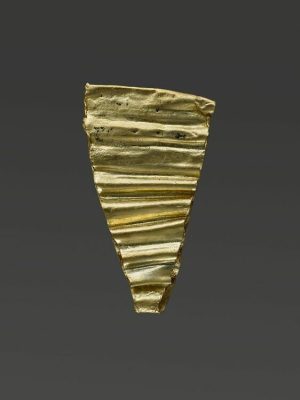
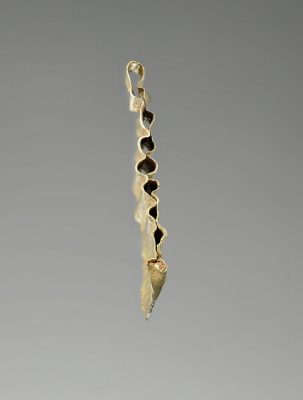
Mari, temple of Ishtar
2500-2340 BCE
Element of a necklace, triangular spacer, made of two wavy sheets, folded one over the other.
Height: 2.83cm; Width: 1.66cm; Thickness: 0.27cm
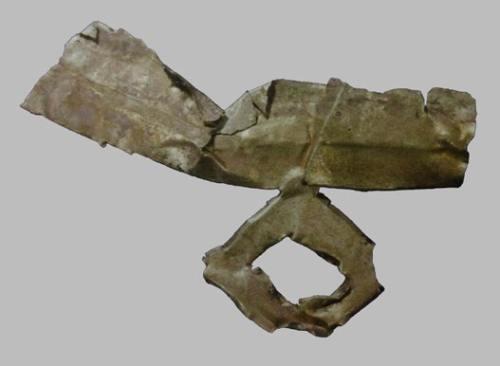
Mari
Sheet, gold
M 2728
L. 27 mm; w. 0.19 g
Early Bronze Age
Damascus, National Museum
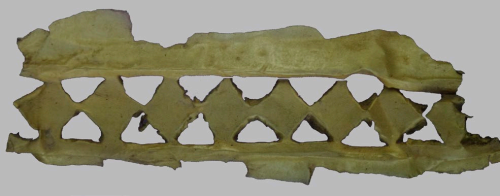
Mari
Mosaic sheet, gold
IXA44NO3
L. 75 mm, 128 mm, th. 4 mm, w. 2.74 g
Early Bronze Age
Deir ez-Zor, Archaeological Museum

Mari, Royal Palace, Room 113; Middle Bronze I
Pendant with granulation, gold
H. 17.8 mm, wid. 11.5 mm, t. 6.5 mm, w. 3.30 g
Damascus, National Museum, M 4549

Mari; Room 119, Great Palace;
Late 3rd/early 2nd millennium BCE
Granulated curved earring, gold
H. 16.3 mm, diam. 17.5 mm,
t. 4.2 mm, w. 2.15 g
Damascus, National Museum,
M 4533
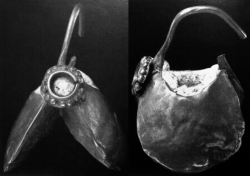
Mari, Tomb 1048
Earring with two pods, gold
IIID1 SE46.TH91.7
H. 24.5 mm, wid. 17.9 mm, th. 18.5 mm, w. 5.05 g
Shakkanakku period
Deir ez-Zor, Archaeological Museum
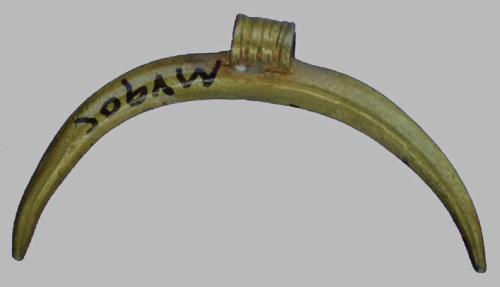
Mari
Crescent-shaped pendant [lunula], gold
M 1114
H. 15.2 mm, wid. 25.4 mm
Middle Bronze I
Amorite or Shakkanakku period
Aleppo, National Museum

Mari, Tomb 300. Early Bronze Age
Decorative disc, gold. Diam. 70/72 mm
Aleppo, National Museum; M 1425
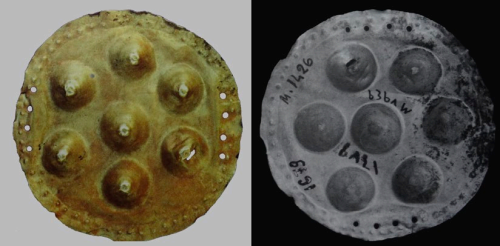
Mari, Tomb 300. Early Bronze Age
Decorative disc, gold. Diam. 55/54 mm
Aleppo, National Museum, M 1426
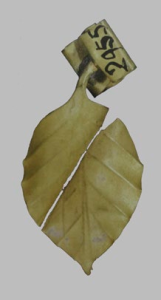
Mari
Pendant in shape of a leaf
Gold. H. 38.6 mm, wid. 19.7 mm
Early Bronze Age
Damascus, National Museum, M 2955

Mari
Pendant in shape of a leaf
Gold. H. 72 mm: wid. 49.3
Temple of Dagan?
Middle Bronze I, late Shakkanakku?
Aleppo, National Museum, M 1843
Ugarit
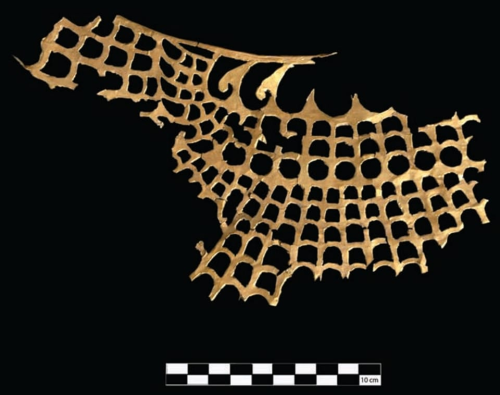
Gold openwork decoration of furniture (a figure of a sphinx?) from Ugarit, Royal Palace, Syria Late Bronze Age
Damascus Museum
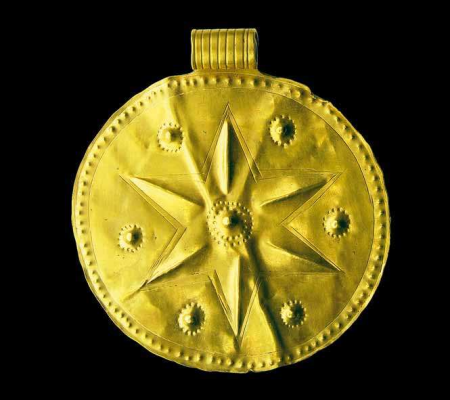
Ugarit
“Circular gold pendant with astral representation from the city of Ugarit, Late Bronze Age, 14th–13th century BC. A line of repoussé dots within an incised band is surrounding the astral patterns illustrating a central star within a cosmic frame. The star was made by hammering work on a relief mould, and then a double line was incised around. The central boss was embossed and surrounded by a double line of dots punched on the surface. This motif is repeated six times around the star.”
[Romain Prévalet, 2014]
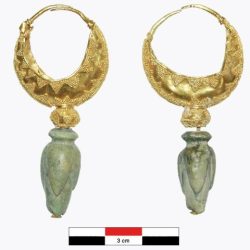
Earrings, Ugarit, Syria 2nd millennium BCE
Pair of a crescent-shape earring decorated of filigree and granulation; a stone is hang up on the top part (crescent-shape and biconical bead). 2nd millennium BCE
Ras Shamra [ancient Ugarit], Tomb IV, House C, Central quarter.
RS 20.57, Inv. Damas: S 2584; RS 20.26, Inv. Damas: S 2582.
Umm el-Marra, 3rd Milenium BCE
Umm el-Marra (ancient Tuba?) in the Jabbul plain east of Aleppo
Lapis lazuli ornament and gold triangular pendant with chain were found among other jewelry and grave goods with two young women in the Tomb 1.

Photo after Glenn Schwartz, Youssef Kanjou [2016]
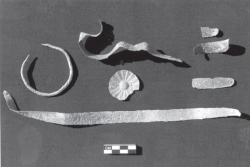
Photo after Glenn M. Schwartz, Hans H. Curvers [2013]

Pendant with chain, gold
H. 2.6 cm, wid. 1.2 cm, th. 0.3 cm, w. 2.6 g.
Chain l. 1.1 cm
Aleppo, National Museum, UMM00 M-032
“Golden, triangular-shaped suspended pendant with a three-link loop-in-loop chain from the elite tomb 1 at Umm el-Marra, Early Bronze Age IVA, 2450–2300 BC. The guilloche pattern decoration of the pendant has been executed with filigree technique probably with hollow block-twisted wires into a frame constituted of plain twisted wires. The surface of the wire is smooth and worn. Brazing was used for soldering the filigree patterns while the details show broken joints indicating that the procedure was not complete and/or enough performed. Each link of the chain is made with block-twisted wire, identified by the helical seam running on the surface.”
[Romain Prévalet, 2014]
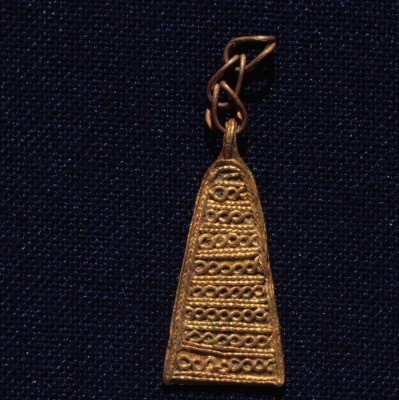
Photo after Glenn Schwartz, Youssef Kanjou [2016]

https://www.nytimes.com/2006/10/24/science/24tomb.html
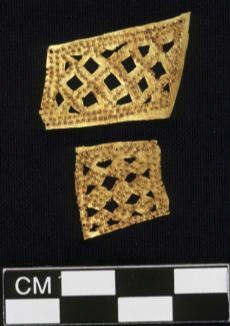
Ornaments made of thin gold sheet and decorated with granules. The larger ornament is about 3 cm long.
Umm el-Marra, Syria, Tomb 4; Early Bronze Age IV [ca. 2200-2100 BCE]
Aleppo, National Museum, UMM04 1-027

Photo after B. Einwag, A. Otto, Antike Welt 1996
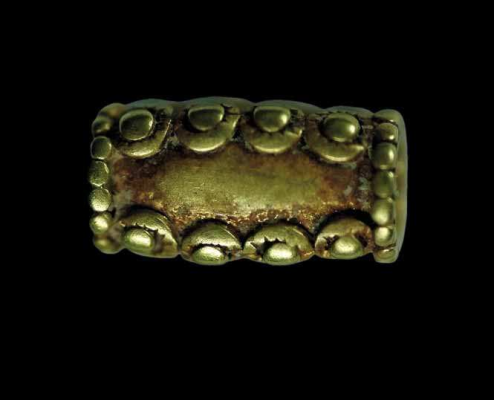
After Romain Prévalet [2014]
Qatna
Pendant with Rayed Star
Qatna, Royal Tomb
15th-14th century BCE
Diam.: 3.9 cm
National Museum of Damascus
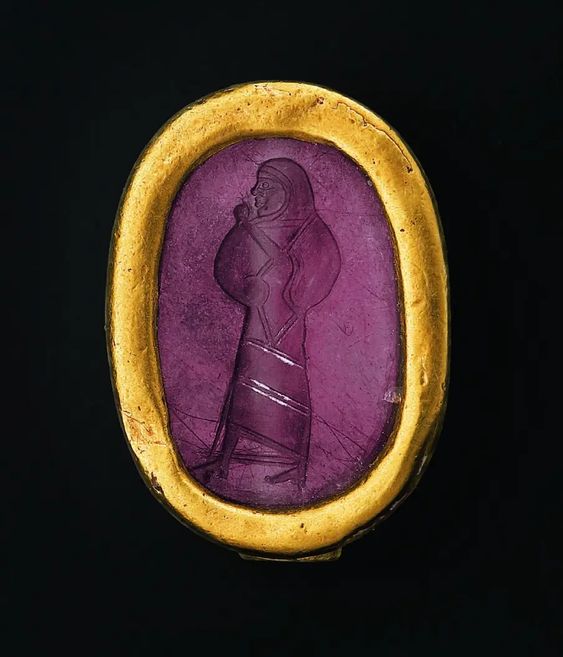
Scarab with Robed Figure
L.: 2.4 cm
Qatna Royal Tomb; 15th-14th century BCE, 18th-17th century BCE
National Museum of Damascus
Das Königtum vom Qatna (2009); Peter Pfälzner
- Romain Prévalet, « Bronze Age Syrian Gold Jewellery – Technological Innovation », Les Carnets de l’Ifpo. La recherche en train de se faire à l’Institut français du Proche-Orient (Hypotheses.org), 2013. http://ifpo.hypotheses.org/5546
- Romain Prévalet, Bronze Age Syrian gold jewellery – Technological innovation (2014), in H. Meller et al. (ed.), Metals of Power – Early gold and silver, 6th Archaeological conference of Central Germany, October 17-19, 2013 in Halle (Saale), p. 423-433. https://www.academia.edu
- Preliminary observation on three Late Bronze Age gold items from Ras Shamra-Ugarit (Syria)
[Observations préliminaires de trois objets en or de l’Âge du Bronze récent de Ras Shamra-Ougarit (Syrie)]
Romain Prévalet p. 129-133, 2009 https://journals.openedition.org/archeosciences/2111 - Paolo Matthiae, New Discoveries at Ebla: The Excavation of the Western Palace and the Royal Necropolis of the Amorite Period; 1984 https://www.jstor.org/stable/3209873
- Tell Umm el-Marra, Syria, Early Bronze Age Results: Final Excavation Report https://whitelevy.fas.harvard.edu
- Introduction to Goldsmith Techniques in Syria during the Early and Middle Bronze Age
Ibrahim Ahmad (2020)
Asia Anteriore Antica. Journal of Ancient Near Eastern Cultures 2: 3-23.
doi: 10.13128/asiana-815 - A 3rd-millennium BC élite tomb from Tell Umm el-Marra, Syria
Published online by Cambridge University Press: 02 January 2015
Glenn M. Schwartz, Hans H. Curvers and Barbara Stuart - A Third-Millennium B.C. Elite Tomb and Other New Evidence from Tell Umm el-Marra, Syria
Article in American Journal of Archaeology · July 2003
Glenn M. Schwartz, Hans H. Curvers
DOI: 10.3764/aja.107.3.325 - Umm el-Marra (Aleppo). From A History of Syria in One Hundred Sites. 2016. Glenn Schwartz, Youssef Kanjou
https://www.academia.edu - Some Gublite Artifact Possibly Made at Ebla; Frances Pinnock; p. 85-100 https://doi.org/10.4000/syria.1547
- MATOÏAN V., AL-BAHLOUL K., 2016, « 66. Ras Shamra / Ugarit (Lattakia) », in J. Kanjou et A. Tsuneki (eds.), A History of Syria in One Hundred Sites, Archeopress Archaeology, Oxford, p. 282-286 https://www.academia.edu
- Das Königtum vom Qatna (2009); Peter Pfälzner https://www.academia.edu


